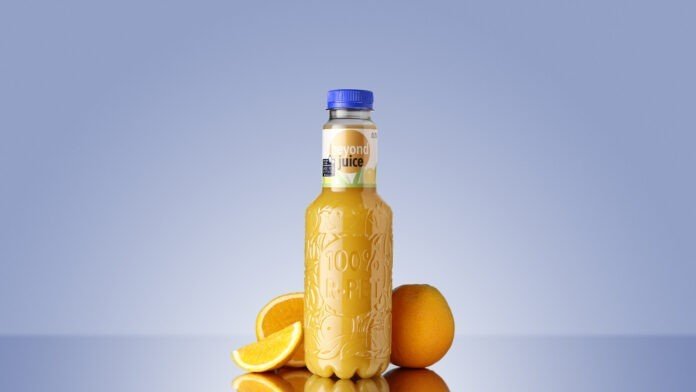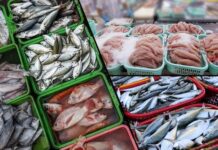
The Bundesrat (upper house of German parliament) recently voted in favor of extending the mandatory deposit on containers to cover all non-returnable plastic bottles and beverage cans. This is good news for the protection of the environment. Besides yielding a higher quota of returns, a high recycling rate positively impacts the eco-balance of beverage packaging. However, implementing this would present a lot of juice producers with several challenges. Their problem is that most plastic bottles filled with sensitive products such as juice cannot be collected by type and recycled to make new bottles due to the composition of their materials. Barrier technologies already established on the market provide an answer here; these protect the liquid food from the gas exchange with the help of a wafer-thin layer of chemically pure glass. Dortmund manufacturer of filling and packaging systems KHS is a pioneer in this field. Since 2002 the corporate group has provided a glass coating technology that enables full bottle-to-bottle recycling under the name of FreshSafe PET.

Plastic bottles should be returned to a deposit machine. However, as is so often the case, unfortunately, there are exceptions to this rule. While a deposit is levied on apple spritzer in non-returnable PET bottles, there is no such obligation for apple juice in the same packaging type. Juice bottles are thus collected through dual waste disposal systems and cannot be recycled to make new Mandatory deposit on containers in Germany. PET bottles in the sense of a circular economy. For consumers, this rule is confusing.
Regarding the protection of the environment, too, the current legislation is also hard to fathom. Due to the limitations of the mandatory deposit system, about 10% of all PET bottles each year are lost to the closed recycling loop, according to a study by packaging market research institute GVM from 2018. This amounts to approximately 40,000 metric tons of plastic per annum that cannot be reused to make food packaging. The German federal state of Hesse has since recognized this problem and, together with Baden-Württemberg, applied to widen the scope of the compulsory deposit on beverage containers in the upper house of the German parliament – with success. This recently voted in favor of extending the mandatory deposit system to cover all non-returnable plastic bottles.
Juice bottles: the problem of recyclability

KHS said this recommendation causes concern to many German juice producers who fill their products into non-deposit one-way PET bottles. Unlike water or many carbonated soft drinks, these sensitive beverages have to be protected against external influences such as oxygen pickup. To ensure this protection, juice and nectar bottles made of PET often contain additives with oxygen absorbers. These additives make them more difficult to recycle than a normal PET bottle. Despite being subjected to elaborate processes, the various materials cannot be separated during recycling and cause discoloration of the recyclate, for example. This complicates pooled recycling with the conventional non-returnable PET containers in the deposit system and renders global bottle-to-bottle recycling, for which 100% pure rPET is required, practically impossible.
According to KHS, one environmentally-friendly alternative is to use an oxygen barrier made of chemically pure glass. The wafer-thin coating on the inside of the PET bottle not only effectively protects the juice from oxygen pickup but is also fully recyclable. During the standard recycling process, the coating is hydrolyzed using hot caustic and removed from the inside bottle wall. It then goes into a solution, and the pure PET can be collected by type.
Available solution
The KHS Group is a pioneer in the field of interior glass coating for PET bottles. For about 15 years now, the systems manufacturer and packaging specialist has offered its customers a fully recyclable system for juice bottles in the food and beverage industries. Bottlers of renown such as Eckes-Granini have been using the eco-friendly packaging system named FreshSafe PET for many years.

The manufacture of the recyclable PET bottle differs only slightly from that of a conventional juice bottle. In both cases, a standard PET preform is used as the basic material. These plastic containers that look like a test tube with a screw top are turned into bottles on a stretch blow molding machine. Here, the preform can be made of new plastic or of recycled material – or what is known as recyclate.
In the FreshSafe PET system, the bottle is then fed to a downstream coating machine. KHS provides this in several different versions and with various capacity ranges. The KHS InnoPET Plasmax 20QS, for example, outputs up to 48,000 bottles per hour. The turnkey supplier’s extensive portfolio also includes two compact block systems. The InnoPET FreshSafe block linked up to a KHS stretch blow molder produces empty coated PET bottles. The KHS InnoPET FreshSafe TriBlock comprising a stretch blow molder, coating machine, and filling unit blows, coats, and fills the bottles on a single machine before these are then sealed.
From pharmaceuticals to food and beverages
The bottles are coated using the Plasma Impulse Chemical Vapor Deposition (PICVD) method, a process first used in the pharmaceutical industry. In this process, a reaction gas mixture is introduced into the PET bottle in a fine vacuum, and this is subsequently transformed into a plasma state by microwaves. In this state, SiOx or chemically pure glass, is deposited on the inside of the bottle.
The interior glass coating is transparent and has a thickness of less than 0.1 µm. It is thus flexibly and chemically bonded to the inside wall of the juice bottle. KHS said this prevents the glass coating from being accidentally removed when force is applied to the PET bottle; for instance, it can only be separated during the recycling process. Due to this particular property, the FreshSafe PET bottle from KHS is 100% bottle-to-bottle recyclable. This has also been recognized by trade associations such as the European PET Bottle Platform and the Association of Plastic Recyclers (USA). Furthermore, the bottle’s suitability for use with foods has also been officially proven. In many countries, including the USA and Europe, the KHS system has food-grade approval.

FreshSafe PET has many benefits
KHS said after coating the FreshSafe PET bottle can be filled with product and provides full protection against both oxygen pickup and loss of CO2 and water vapor. In this way, the Plasmax coating prevents the sensitive beverage’s quality from being compromised and means that the product keeps up to ten times longer than in uncoated plastic bottles.
In addition, glass-coated PET juice bottles have several further benefits for the consumer and the environment. For instance, plastic bottles are much lighter than glass bottles. This positively impacts the amount of CO2 emitted by trucks as fewer bottles, or lower load weights mean less gas consumption. Plastic bottles are also unbreakable and flexible.
In addition to environmental aspects and the protection of the product, the economy is also essential. On the one hand, due to the glass coating, the amount of plastic used compared to containers with oxygen absorbers is lower, thus yielding cost savings. On the other, bottlers can work with standard PET preforms, further reducing the cost per bottle.
KHS promotes the closed recycling loop
According to KHS, the FreshSafe PET system’s advantage, however, lies in its ability to be fully recycled to produce pure PET. With this, the KHS Group supports efforts to create a closed PET recycling loop and facilitate bottle-to-bottle recycling. This is essential if plastic bottles have a positive eco-balance, as the ALPLA LCA Packaging study carried out last year illustrates.
To continue to boost the high recycling rate of about 93% for PET bottles in Germany and further strengthen the bottle-to-bottle recycling loop, the KHS Group recently introduced an innovative bottle concept for sensitive beverages. Its Beyond Juice bottle is a fully recyclable PET bottle made entirely of recycled materials. Due to the FreshSafe PET barrier system, it provides outstanding product protection. Environmental service provider Interseroh has issued the container with its Made for Recycling seal of quality. KHS said that the Beyond Juice bottle is the first PET bottle ever to score a full 20 out of 20 points in this rating system.
KHS stated with the new bottle concept, juice producers can save more than 1,500 metric tons of raw materials at a production of 50 million bottles a year. In doing so, they are helping to improve the eco-balance of plastic packaging. The Beyond Juice bottle is even more environmentally friendly in combination with Nature MultiPack from KHS. This container system holds bottles together with dots of adhesive, which are strong and secure yet easy to remove. With the help of this tried-and-tested packaging variant, the plastic film otherwise used to form PET bottles into packs of six, for example, is no longer required. This claims to reduce the amount of packaging waste by up to 90%. Like the coated PET juice bottles, the dots of adhesive are also fully recyclable.
KHS in India
With its headquarters and factory in Ahmedabad, Gujarat, West India, on a production site of 18,000 square meters, KHS Machinery plays a significant role in supplying the KHS portfolio to customers from India and Southeast Asia. KHS India started as a joint venture, with 60% ownership of KHS Germany. Over the years, it increased its share to more than 95% today but also helped expand the pie. The company, which was created to cater only to the Indian market, slowly spread its wings and started exporting to markets in Southeast Asia, China, and Australia with the support of KHS Germany.
IndiFoodBev — authentic, impactful and influential
An English-language food and beverage processing and packaging industry B2B platform in print and web, IndiFoodBev is in its third year of publication. It is said that the Indian food and beverage industries represent approximately US$ 900 billion in revenues which implies more than 20% of the country’s GDP. Eliminating the wastage on the farmside can help to deliver more protein to a higher number of the population apart from generating sizable exports. The savings in soil, seeds, water, fertilizer, energy and ultimately food and nutrition could be the most immense contribution that country is poised to make to the moderation of climate change.
To improve your marketing and grow sales to the food and beverage processing and packaging industry, talk to us. Our research and consulting company IppStar [www.ippstar.org] can assess your potential and addressable markets in light of the competition. We can discuss marketing, communication, and sales strategies for market entry and growth.
Suppliers and service providers with a strategy and budget for targeted marketing can discuss using our hybrid print, web, video, and social media channels to create brand recognition linked to market relevance. Our technical writers are ready to meet you and your customers for content.
The second largest producer of fruit and vegetables in the world is continuously expanding processing capacities and delivery systems with appropriate innovative technologies. We cover product and consumer trends, nutrition, processing, research, equipment and packaging from farm to thali. Get our 2025 media kit and recalibrate your role in this dynamic market. Enhance your visibility and relevance to existing markets and turn potential customers into conversations. Ask for a sample copy of our bi-monthly in print or our weekly IndiFoodBev eZine each Wednesday.
For editorial info@ippgroup.in — for advertisement ads1@ippgroup.in and for subscriptions subscription@ippgroup.in
Naresh Khanna – 10 February 2025
Subscribe Now










